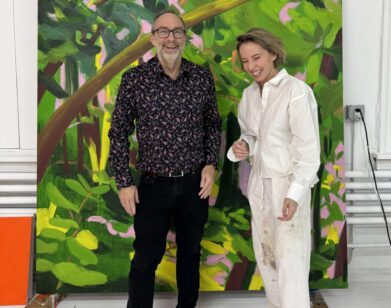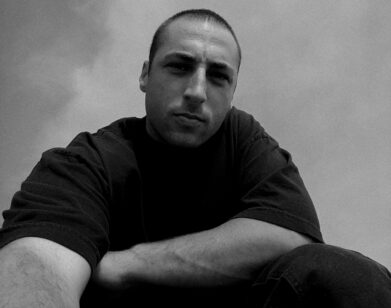Interview Presents Horizon, An Immersive Art Experience By Cadillac
In a conversation with Ross Miller for this magazine in 1990, the legendary, rectilinear-averse architect Frank Gehry said, “I tried to see every event in a piece of architecture as a painting: the corner window, the front window, the kitchen window. As I experimented with my own house, I was trying very hard within the wood, glass, and metal technologies to invent a new landscape for each piece.” The Internet hadn’t yet been made public, and already forward-thinking creatives were exploring the relationship between art and tech.
A lot has changed since then, but that investigation remains. Take, for example, Midnight Commercial, a New York-based technology, arts, and design innovation consultancy comprised of MIT Media Lab alumni, including managing partner, David Nuñez, and partner and head of design, Dr. Daniel Rosenberg. To hear them tell it, the projects that most inspire them—a microscopic aquarium for Google, a robotic barista for GE—marry innovation with artistry to create something entirely new.
It was with open arms, then, that they embraced the challenge of using Cadillac’s groundbreaking new Rear Camera Mirror to design an interactive art installation to coincide with this year’s Marfa Film Festival. In collaboration with Gentex Corporation, the storied car company has come up with a cutting-edge way for a driver to see in their wake—even if the backseat is piled to the roof with luggage. With a touch, Cadillac has made it possible to switch between the traditional rear-view mirror, as we know it, to a high-definition video feed streaming from a rear-mounted camera. Interested in expanding the creative possibilities of their new Rear Camera Mirror, Cadillac sought to showcase its ability to enhance perspective by taking the Rear Camera Mirror out of the car and creating an artistic expression of the technology. It was this out of the box thinking that attracted Midnight Commercial to the project.
With Texas as their inspirational roadmap, Nuñez and Rosenberg conceived Horizon, a horizontal ring with 200 Rear Camera Mirrors mounted on its outer surface. As visitors approach the living sculpture, the pulsing gradient of colors in the mirrors—evocative of the desert at dusk and dawn—intensifies. Although nothing quite compares to a Marfa sunset, Cadillac and Midnight Commercial have come together to create a stunning piece of tech-driven art that comes pretty close.
INTERVIEW: Hi, guys. First things first: Tell us about Midnight Commercial.
DANIEL ROSENBERG: We use technology and materials—things you can touch—to create products or experiences that’s also art. As an artist, you might use paint or a brush to create something. In our case, technology is a part of our palette.
DAVID NUÑEZ: We are living in an age when the digital universe and the physical universe are fractured. At Midnight, we use technology to bridge that gap. The challenge is always to create projects that are as physical as they are digital, so that we can have a holistic human experience.
INTERVIEW: How did you come up with the name? To me, it calls to mind those infomercials that people used to watch on TV when they couldn’t sleep.
NUÑEZ: “Midnight Commercial” evokes the moment between days when you stop to reflect on what’s already happened and what’s about to happen next. At MIT, the culture was definitely about working late into the night, with everybody building stuff together.
INTERVIEW: Technology is often perceived as mathematical, perhaps even a bit dry. Can it be a medium of expression?
ROSENBERG: I like to think of design as cooking: you use different ingredients you find in your kitchen, mix them up, and create something to eat. For me, technology is one of these ingredients—a spicy one. Technology is most often associated with the visual sensory experience, but we also want to bring in tangible, auditory experiences.
NUÑEZ: When people find out that we come from MIT, and that we have a background in engineering, there’s automatically this sense that we’re nerds, that we sit around programming computers all day. And yes, we do all of that, but we also have a desire to express ourselves. Which is why we’ve created a place where misfit nerds can come together and make beautiful works of art. We have something to say, and because we’re good with technology, the way we say those things is quite unique.
ROSENBERG: We’re in the infancy of technology as art. Painting has been around for centuries, but technology is pretty new. People are trying things out and seeing what they can do with it.
NUÑEZ: We love working with stuff that’s never been seen before. We love getting our hands dirty with new toys. We love building things, seeing what technology can do. As soon as we had the Rear Camera Mirrors in our hands, we saw what they were capable of doing. There’s the mirror, of course, but then you flip a switch and suddenly this other world appears in beautiful high resolution on the screen. Lightbulbs went off in all of our heads.
INTERVIEW: In what ways did Marfa inform your new piece, Horizon?
NUÑEZ: It’s this place in the middle of the desert, surrounded by nothingness, where people are making these amazing works of creativity. It’s almost spiritual, not just the artwork but also that desert landscape. As a kid I remember seeing the Marfa lights—
INTERVIEW: Wait, what are the Marfa lights?
NUÑEZ: It’s this strange phenomenon where these little balls of light float through the area. Nobody knows where they come from. There have been scientific studies about what might cause them, but no can say for sure. I have vivid memories of being a kid in Texas and going on road trips with my family. I grew up in El Paso, so to get to Austin or Houston meant spending at least eight hours in the car, with nothing out the window but the desert landscape. That was the inspiration for this piece: a road trip, thinking about the boundaries between physical and digital spaces, about the horizon of what you can see, what you experience. Knowing that it was going to be initially placed in Marfa felt like a really good moment for us.
ROSENBERG: At some point after presenting this idea, we received the Rear Camera Mirrors; it was really important, experiencing the material, touching it. We had the idea to create another world, using this cool new technology pioneered by Cadillac and Gentex, and inspired by Marfa, which would appear in these Rear Camera Mirrors as if through a portal.
INTERVIEW: How did you actually create that portal? How was Horizon born from that technology?
NUÑEZ: Horizon is comprised of 200 Gentex Rear Camera Mirrors, which are connected to cameras that point at 200 LCD screens. We wrote a lot custom software to adjust what’s being played on those LCD screens. We also added sensors to each mirror so that as a user moves in relation to Horizon, the mirror around the sensor registers that movement, instructing the software to show a different perspective on the LCD screen. In that way, we’re able to create this feeling of looking through virtual space.
INTERVIEW: Tell us about your relationship to Cadillac. What excited you about working with the brand?
NUÑEZ: Cadillac had an idea to re-contextualize this vehicle feature into an artwork, and we were thrilled when they chose Midnight Commercial to tackle the creative and technical challenges required to realize this vision.
INTERVIEW: On the topic of that story you’re trying to tell: What do you hope viewers will take away from Horizon?
ROSENBERG: A memorable experience. We want them to say, “We saw this thing, and it was super interesting. I was surprised by it. I want to tell you about it.”
NUÑEZ: We’re really excited about this piece because people will have their hands all over it. They’ll be moving it. They’ll be experiencing the tangible interface. That’s not usual in a gallery setting—people aren’t usually allowed to touch the art.







